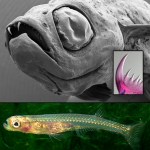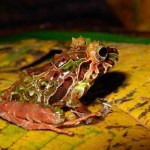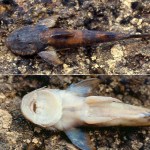new species
A new kind of fish with Dracula style fangs has been discovered...in a fish tank that researchers had been keeping for a year. The fish had been living at the London Museum of Natural History for almost 12 months before scientists realized that they were a new species. They had been collected in Burma.
Which is your favorite movie in the Underworld trilogy? Ours is the latest, Rise of the Lychans.
The pointy fangs seen in the picture are actually not true teeth, but only bony protrusions coming from the fish's jaws. Furthermore researchers don't believe that the fangs are used for feeding…
Last April we brought you images of a newly discovered frogfish with some unusual characteristics. Here are two videos of the Histiophryne psychedelica in action. After almost a year it has been confirmed, by the way, that this fish is indeed a new species to science.
When the fish opens its mouth for the second time, hit play on the Darkside of the Moon.
It bounces off of coral like a superball!
Researchers in a remote Colombian jungle have identified 10 new species of amphibian. Keeping with Zooillogix's official policy, because the creatures are finally known to Western science, now and only now can we all consider them to exist. Scientists from Conservation International and the Ecotropico Foundation explored the mountains in the Tacarcuna area of the Darien near Panama to discover the new species.
Oranged-legged rain frog
Many more below the fold...
Another kind of rain frog
Salamander Bolitoglossa taylori
Poisonous frog of the Dendrobatidae famlily
Glass frog of the…
Though scientists have actually known about a strange climbing catfish from the jungles of Venezuela for 20 years, it took them until last month to capture live specimens and officially name the creatures. The catfish, dubbed the Lithogenes wahari were found clinging to rocks in the Venezuelan state of Amazonas. Interesting side note, the Venzuelan government named this province after Cirque Du Soleil's latest Vegas production.
Nice legs...
The Lithogenes wahari has some incredible adaptations for living in the fast moving water. It possesses a set of highly developed pelvic fins that…
Researchers have released the findings of a ten year study into the wildlife of the Greater Mekong River area in Southeast Asia -- Over 1000 new species discovered!
Before you all break into a heated, name-calling brawl on whether these should actually be called "new species" or "species that are new to science" or "species that are new to 'Western' science", allow Andrew and me to put the issue to rest: These species should be considered not only new species to science, but new species to humanity and to the world, as this is the first time that Western scientists, i.e. imporant people,…
Forelius damiani Guerrero & Fernández 2008
Colombia
The ant genus Forelius - named for the eminent Swiss myrmecologist Auguste Forel- is known for its abundance in hot, dry climates in both North and South America. This affinity for deserts has given the genus a markedly disjunct distribution, abundant in subtropical South America and in the warmer regions of North and Central America but absent in the more humid intervening climes. Or so we'd assumed.
Last week Colombian myrmecologists Roberto Guerrero & Fernando Fernández filled the gap with a newly-discovered…
An expedition to a tiny island in the South Pacific's Republic of Vanatu has yielded hundreds of new species, including possibly 1000 new species of crab.
Squat lobster
153 scientists from 20 countries participated in the survey of Espiritu Santo in the South Pacific, scouring caves, mountains, reefs, shallows, and forests collecting species. Out of over 10,000 species collected, the researchers are predicting that as many as 2000 may be previously unknown to the scientific community. Some pics from the National Geographic story are below, but we encourage you to visit this article and…
The Census of Marine life is the gift that keeps on giving. Here are the latest pics of some new species they've discovered at the bottom of the ocean.
A blind lobster from the genus--Thaumastochelopsis
Sweet new comb jelly
More below the fold...
Ampelisca mississippiana - a new kind of amphipod
New species of squat lobster
Adorable new pebble crab
A new species of shrimp, seen here standing on a yellow worm (they both eat the same marine plants)
Read more about these species on nationalgeographic.com.
tags: Lepidodactylus buleli, new species discovered, Vanuatu gecko, reptiles, Ivan Ineich, Natural History Museum Paris France
French scientist, Ivan Ineich, displays a never-before-seen species of gecko at France's Natural History Museum in Paris. This gecko, formally described with the Latin name, Lepidodactylus buleli, was born in Paris from an egg that was removed from the rainforest canopy on the west coast of Espiritu Santo, one of the larger islands of the Vanuatu Archipelago, east of Australia in the South Pacific Ocean.
IMAGE: Francois Mori (AP Photo) [larger view].
According…
Pheidole rugithorax Eguchi 2008 - Vietnam
In today's Zootaxa, Katsuyuki Eguchi has a taxonomic revision of the northern Vietnamese Pheidole, recognizing six new ant species for a genus that is already the world's most diverse. The revision also contains several nomeclatural changes and a key to the thirty or so species occurring in the region.
As in most tropical taxonomy this research has a comedic/tragic effect of adding several more species, about which nothing is known, to a catalog already overflowing with equally mysterious species. We don't know what they eat, how long…
Lachnomyrmex amazonicus - Feitosa and Brandão 2008
The new world tropics continue to be a rich source of species discovery. Today's issue of Zootaxa contains a monograph by Rodrigo Feitosa and Beto Brandão revising the ant genus Lachnomyrmex, a small yet delightfully wrinkled group of soil-dwelling ants. Of the 16 species recognized in the new paper, ten were previously unknown. For the mathematically-challenged, that's more than half.
Lachnomyrmex amazonicus, pictured above, is one of the new species. It has been recorded from lowland humid forests in the…
Subterranean...blind...predatory...smokin' hot AILF! These are all adjectives that you could use to describe a newly discovered ant from the Amazon rainforest. Dubbed the Martialis heureka or "Ant from Mars" (not kidding), the sightless creature lives inside the soil and presumably hunts prey with massive mandibles. The Ant from Mars also represents a new subfamily of ant, a discovery that hasn't happened since 1923 (Note: see comments for various competing view points).
Take me to your watermelon.
After evaluating the DNA of the ant, researchers have concluded that this ant is on the bottom…
Asphinctopone differens Bolton & Fisher 2008
A new species from the Central African Republic
Bolton & Fisher Revise Asphinctopone (Zootaxa)
Shattuck Revises the Indo-Pacific Prionopelta
All imported Fire Ants in the U.S. are descended from 9-20 initial foundress queens
[summary in ScienceDaily]
ZooKeys: A new open-access journal for biodiversity & taxonomy
What is the Ghost Slug?
by the Museum of Wales
"Unlike most slugs, the Ghost Slug is carnivorous, killing earthworms at night with powerful, blade-like teeth, sucking them in like spaghetti. It is also unusual in having no eyes (it is probably blind) and is almost completely white. It spends most of its time underground, squeezing its flexible body into cracks or tunnels to get at earthworms, which it detects by smell or taste."
Yup, you read that last part right. After the story of the slug infestation wreaking havoc on the UK's gardens this year, things are getting worse for the Brits.…
In 2006 two eager shell collectors hauled in some small but strangely shaped mollusks in deep water off Key West, Florida. Like the good animal nerds they were, they brought their findings to a shell collectors convention in Mobile, Alabama where the Director of the Bailey-Matthews Shell Museum on Sanibel Island, Jose H. Leal, took up the challenge of identifying the critters.
Two years later, Leal finally published his findings in the May 7th edition of Zootaxa, announcing that the heart-shaped bivalves were an entirely new genus. As explained to Florida's News-Press by Leal, "This…
The Arizona State University's Institute for Species Exploration has released their much anticipated picks for the top ten best new species discovered in the last year. From a rhinosaurus beetle that looks like a Pixar character to a fruit bat the fills in some evolutionary holes, this list supposedly has it all.
O Magazine called hot pink centipedes the MUST HAVE accessory for the summer.
Taking a cue from the Brother's Bleiman, the ASU Top Ten List sometimes attempts to combine humor with science...By clicking on the link below, you will see that it fails.
Click here to view the top ten…
Pheidole pegasus Sarnat 2008
Fiji
Eli Sarnat, the reigning expert on the Ants of Fiji, has just published a lovely taxonomic revision of a group of Pheidole that occur on the islands. Pheidole are found in warmer regions worldwide, but Fiji has seen a remarkable radiation of species that share a bizarre set of spines on the mesosoma. Eli sorted through hundreds of these things to determine that the group contains seven species, five of which had not previously been described. Pheidole pegasus is largest and among the most distinct of the group. It was collected only once, from the…
A completely new family of fishes may have been discovered in the coral beds of Indonesia. Dive company owners, Buck and Fitrie Randolph of Maluku Divers spotted the fish in January but waited to photograph additional specimens before contacting the experts. Interviewed by Seattle PI, University of Washington ichthyologist Ted Pietsch, who specializes in anglerfish, said it was unlike anything he had ever seen, sputtering "I'm still thrilled. It's an incredible thing. It's remarkable."
The pink-and-tan striped frogfish cannot be identified by any fish experts so far. While Pietsch is…
Scientists have discovered two new species of animal recently, one in Tanzania and the other in Nepal. Though the researchers had spotted the giant, cat-sized shrew (Rhynchocyon udzungwensis) as far back as 2005 in Tanzania, they have now identified it as a new kind of giant sengi.
The findings were published in the Feb. 4 issue of the Journal of Zoology.
Meanwhile, in the wetlands of southern Nepal, scientists captured a new kind of warbler. It is a sub-species that seems to be the "missing link" between two other species of warbler...blah, blah, blah. Let's get back to the massive…
National Geographic reported this weekend that three new species of salamander have been discovered in distant cloud forests of Costa Rica's La Amistad National Park. Just like X-Men, each salamander seems to have a special power: "one with a bold streak, one with a 'ballistic' tongue, and one no longer than a fingernail," according to Nat'l Geographic.
La Amistad is the largest wildlife reserve in Central America, and...
...much of it has yet to be explored.
This salamander has markings reminiscent of a poison dart frog, possibly an environmental ruse.
In the article, Alex Monro of…


